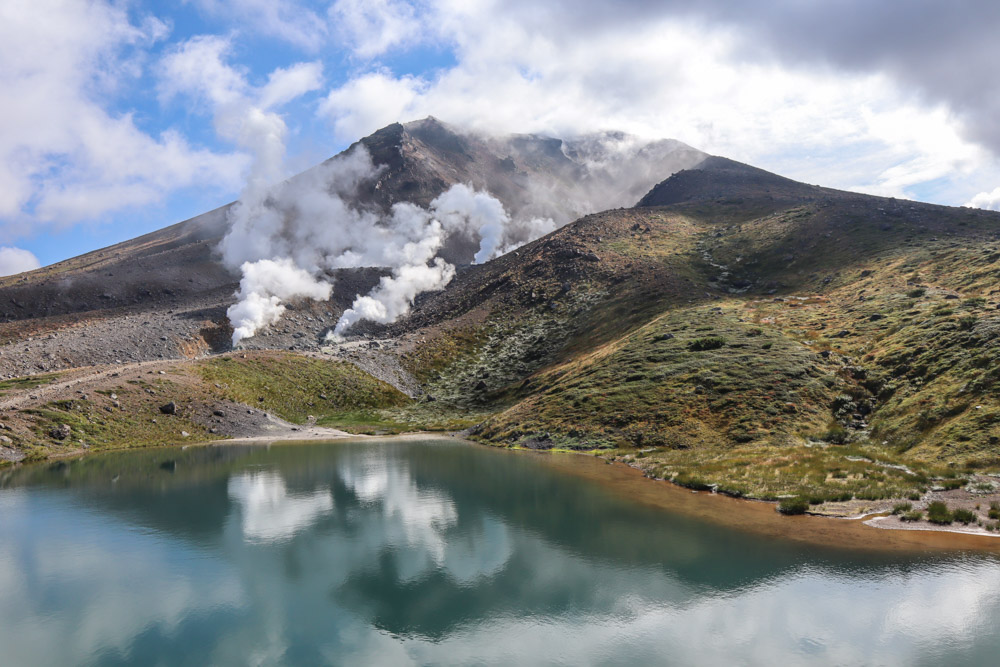This article has links to products and services we love, which we may make commission from.
If hiking or biking by day then soaking in a hot spring onsen bath under the stars at night is your kind of trip then our Hokkaido itinerary is for you.
Hokkaido in northern Japan is the second biggest island and a playground for adventure lovers. The island itself is massive with lots of opportunities for outdoors fans, too much almost, so selecting which are of the island to focus on can be a challenge.
We spent five days in Japan’s Kamikawa subprefecture, with most of our time outdoors in Daisetsuzan National Park (early September). The benefits of choosing this region as your Hokkaido road trip include:
- You can fly into Asahikawa and rent a car in the city/at the airport
- You skip the toll fee at Sapporo, Hokkaido’s capital city
- Daisetsuzan National Park is not a tourist spot like Furano, Biei or Blue Pond
- You can still see bears but ethically, unlike other bear areas in Hokkaido
Tip: Remember that Japan is pretty much a cash-only country. You will find ATMs that foreigners can use at 7/11 shops and Post Offices. As you are about to do a Hokkaido road trip through rural Japan, there won’t be as many ATM opportunities than in the likes of Tokyo so take out money whenever you see a 7/11.
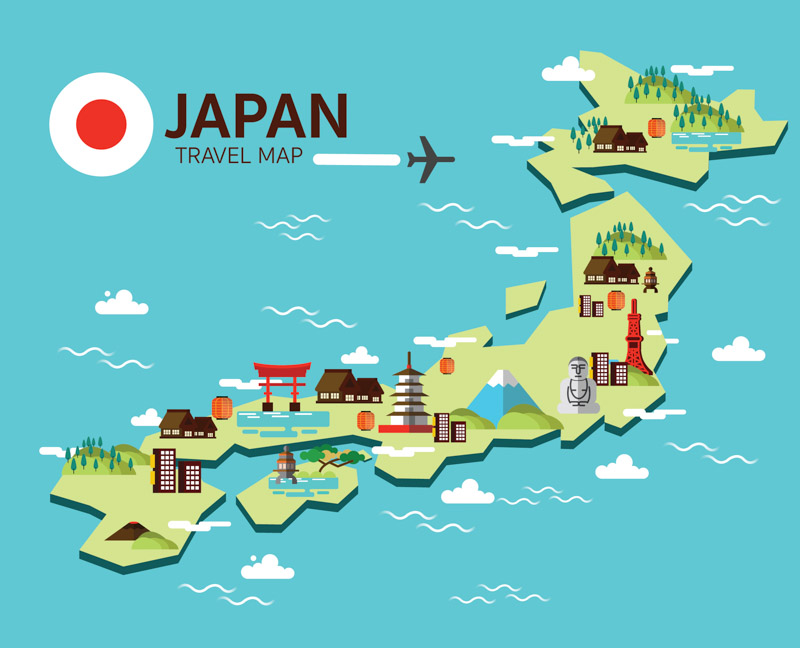
5 Day Hokkaido Itinerary
Day 1 Asahikawa City
Asahikawa is a quiet city in central Hokkaido. You can fly into Asahikawa Airport then take the public bus into the city to pick up your rental car. Asahikawa Station is perfectly located for those arriving by train.
Although you can collect your rental car from Asahikawa Airport, I think it is worth spending a day in Asahikawa visiting the city highlights such as Otokoyama Sake Brewery, Kamikawa Shrine and Asahikawa City Museum.
At Asahikawa Museum you can learn about Ainu culture in Hokkaido, previously called Ezo, through the artefacts over the two floors of the museum. This is a great starting point for hitting the hills in Hokkaido because Ainu people believe strongly in the power of nature.
» Read more: Things to do in Asahikawa
For dinner, consider a traditional Japenese Izakaya such as Izakaya Tenkin.
Here, visitors sit around a low table and eat a selection of food such as seafood and fried chicken then wash it down with a beer and/or sake. Not too much though, reserve your energy for an early start tomorrow.
Remember to take out money from a 7/11 ATM to cover you for your trip.
Accommodation: Asahikawa Art Hotel. Hotel parking if required.
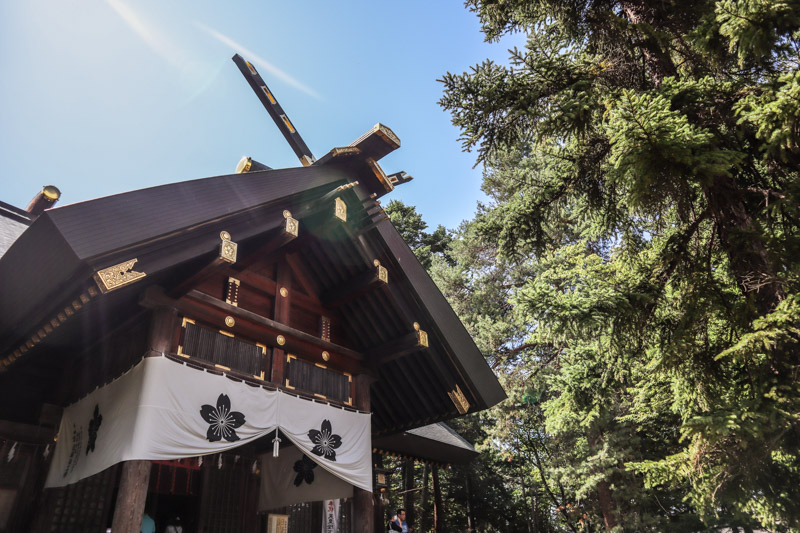
Day 2: Asahidake
Asahikawa to Higashikawa: 22 minutes drive.
On day two of this Hokkaido itinerary, we head to the hills stopping off at the hipster town of Higashikawa.
Higashikawa, the town of photography, has risen in popularity over the years. Its forward-thinking mayor has encouraged incomers to settle in the town which has brought about a vibrant and young family-friendly crowd.
Interestingly, Higashikawa is the only town in Hokkaido that doesn’t need to rely on paid-for public water supply, as they enjoy the fruits of Mount Daisetsu.
The water is renowned, so much so, even the Asahikawa city restaurants fill up water containers for their eateries.
In Higashikawa, stop off at Chamise to purchase some local rice balls filled with tuna mayonnaise, meat or veggies for lunch.
Pick up hiking snacks at Higashikawa Hokuren Supermarket (1 Chome-5-1 Minamimachi) before hitting the road to Asahidake.
Note: The word onsen is added to the areas of Daisetsuzan National Park so you will see it repeated throughout this guide. Confusingly, the word onsen also refers to the hot spring baths in hotels at Daisetsuzan National Park.
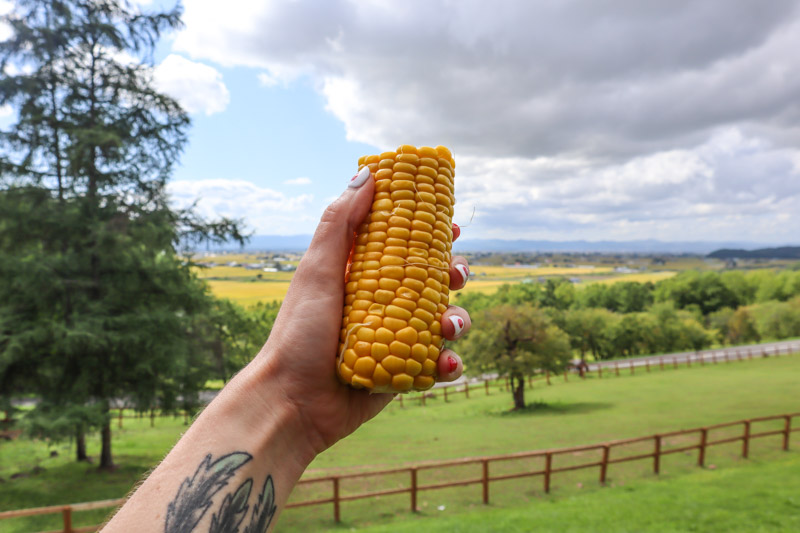
Arrive at Asahidake Onsen, approximately 35 minutes drive from Higashikawa.
Leave your luggage with Hotel La Vista Daisetsuzan (〒071-1472 Hokkaido) grabbing a complimentary hot chocolate and ice cream in the hotel lobby.
Stretch your legs by taking a stroll around the Asahidake Visitor Centre. You can walk a loop of the wetlands in under two hours, but it is very wet underfoot so consider this for your next full day of hiking.
Look out for the purple flower, Gentiana triflora, which uniquely grows at higher altitudes. You’ll see it often throughout the activities in this itinerary. National Park rules in Japan state not to pick flowers.
Check out the height of the sign on the forest trees. Any guesses why the signs are so high? Yes, that’s the height of the snow you can expect at Asahidake Onsen come winter.
Naturally, you need to be alert. Make lots of noise to warn any brown bears that you are in the vicinity. Save the bear spotting for day three!
Next, check-in at La Vista, enjoy the rustic rooms and cool coffee grinders.
Make use of the private onsens baths, aiming for the room with the romantic inside and outside bath at the end of the corridor.
As the baths are private, there are no issues for customers with tattoos, like us.
There is also a communal onsen, gender-specific if you prefer.
Onsen hot spring-fed baths are a very big part of Japenese culture. You do have to enter naked and wash before entering.
Onsen hotels always provide a robe, tie and shoes which you wear to the onsen. La Vista rooms have a cute picnic-like basket for you to pack your belongings.
Dinner can be, and should be, reserved at time of booking. Kaiseki-style dining is a really special experience in Japan.
Several bowls and plates resembling trinkets are served throughout dinner. Lift lids to reveal seafood, local meats, vegetables and tofu.
Sizzle meat on your private BBQ, which the Japanese refer to as Yakiniku.
If you are not a seafood eater, let the hotel know at the time of booking. Craig enjoyed the ‘meat seat’ while I dined on seafood.
Let your food digest then enjoy another onsen. Yes, another! That’s how the Japenese utilise their time during their ryokan hotel stays.
Tip: You can book traditional ryokan hotel rooms with tatami mats or western style rooms with beds.
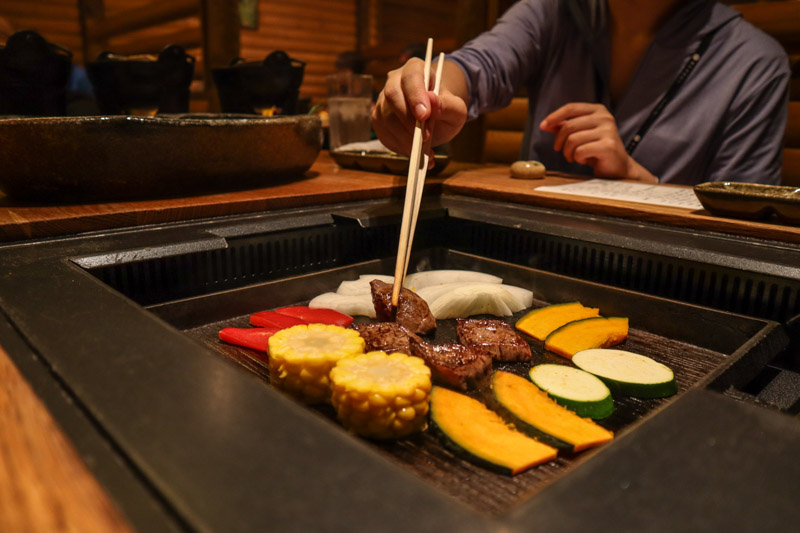
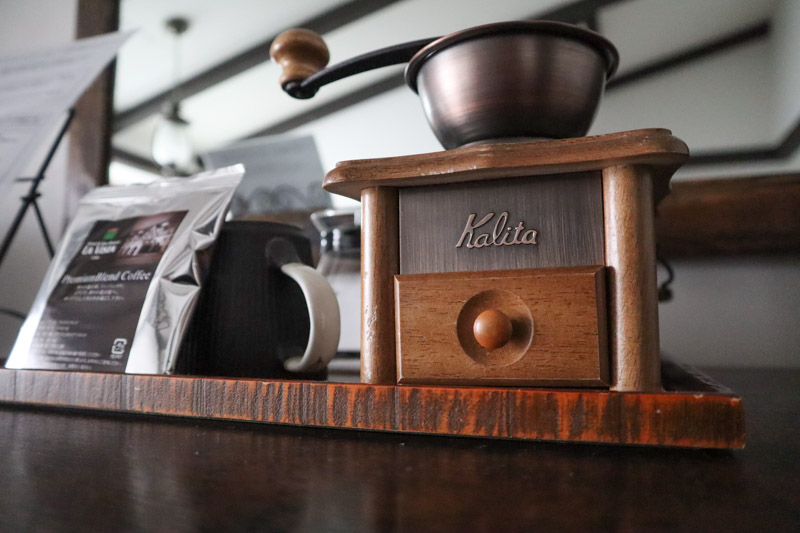
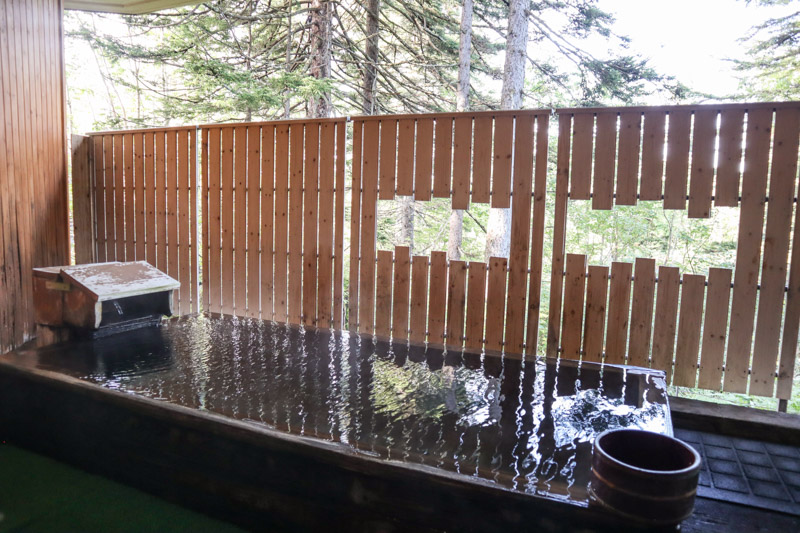
Day 3: Mount Asahidake
Wake early and fill up on the La Vista buffet breakfast. Like most accommodation in Japan, there are Japenese and western options.
Aim to be out for 7:45 to catch an early ropeway (cable car) schedule. The Ropeway runs every 15-20 minutes, season depending. The drive between the hotel and the Ropeway only takes a couple of minutes but if you intend to use the car park, factor that time into planning.
You can leave your car the car park close to the Ropeway for free, or for a fee (cash only) at the Ropeway if you intend to descend Mt Asahidake. There are free toilets at the Base Station as well as at the Sugatami Summit Station.
The Asahidake Ropeway is some ride. Watch the sea of trees become smaller from the massive windows of the ropeway carriage as you make your way to the summit station of the tallest mountain in Hokkaido. Watch out for your ears popping.
Just imagine all these leaves turning orange and red mid-September then within a week, the snow starting to fall and skiers and boarders filling the cable car.
I get the impression you’ve not seen the Kamikawa unless you’ve experienced it in all four seasons which gives us an excuse to return.
Doors open, Sulphur wafts in, welcome to Mount Asahidake!
Important note: This is your last stop to use a public toilet and using nature’s toilet is frowned upon in Daisetsuzan National Park. There is a shop here too, cash only.
We are featured in the official tourism video. Check it out below
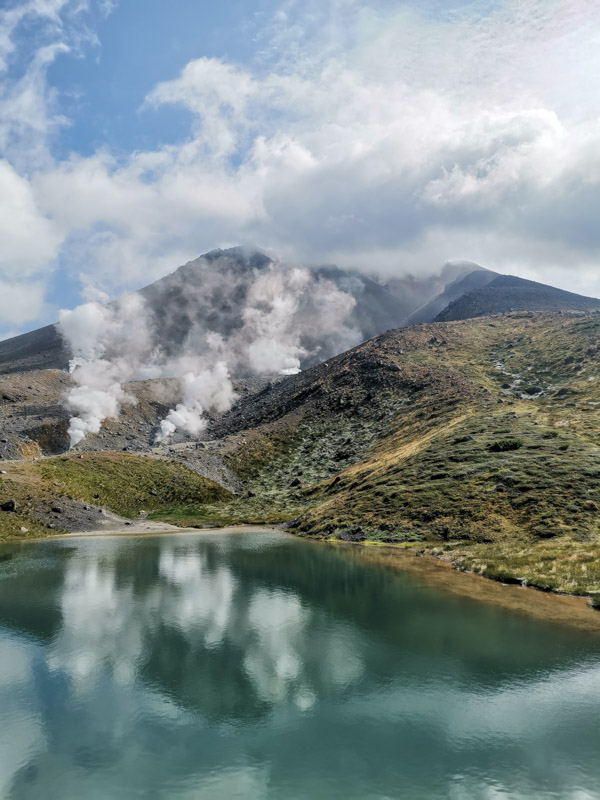
The initial part of the trek is more like a casual stroll up the lake which has smoke from geothermal vents ranting around it.
From there, the incline starts to build. Most of the hike is loose underfoot so appropriate footwear must be worn.
Regardless of how warm it is on the ground, the weather up the mountain changes like the wind (boom boom).
Layers, waterproofs, hats and gloves must be worn/packed. I wore a vest top, wicking wool layer, waterproof jacket and wished I had a down jacket for warmth.
Mountainous hikes in Japan are broken up by gates. The gates measure either the height or distance divided up ten. Cable cars usually start around gate five.
We reached the peak at 2,291m in a complete white-out after 2.5 hours of incline.
We had full intentions to hike over to Kurodake hut and end the descend into Sounkyo Onsen but the mountain had different ideas for us so the group decided to choose safety first (always) and head back down to Asahidake Ropeway.
About halfway down the mountain, the mist lifted and we could see the lake and vents again. The descend took around 1.5 hours so all in all a 4.5-hour hike with cable car rides at either end.
Alternatively, if you don’t want to hike up to the peak of Mount Asahidake you can walk the 1-hour loop around Kagami Pond (Meoto Pond), Sugatami Pond and Suribachi Pond. The route is under 2km.
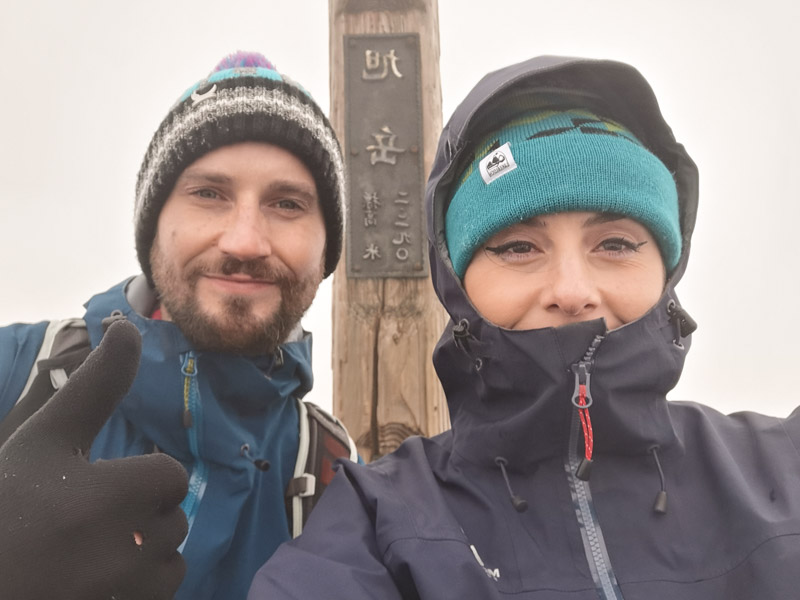
Daisetsu Kogen Sanso
Accommodation for the night is one of my favourites in Japan.
Daisetsu Kogen Sanso is a relaxed hotel with traditional Japanese rooms.
What makes this place extra special is that it is only open for 123 days of the year because the dirt road to get there is blocked off in winter.
Be warned, the drive is bumpy as you turn off the main road to a dirt track road. One European couple managed to roll their car while we were there so be careful driving up and down.
The journey from Mount Asahidake takes around 2-3 hours.
When we first walked into the empty room with tatami mats, Craig thought it was a judo room!
There was a table sat in the middle and a box packed with two robes, feet socks and towels. Curtains opened to trees and small geothermal vent. Onsen hotels are absolute bliss and definitely one of the top things do in Hokkaido.
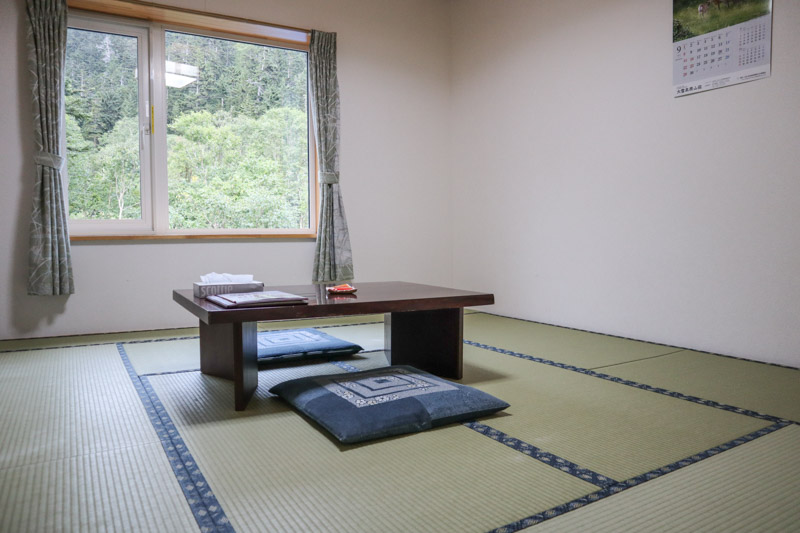
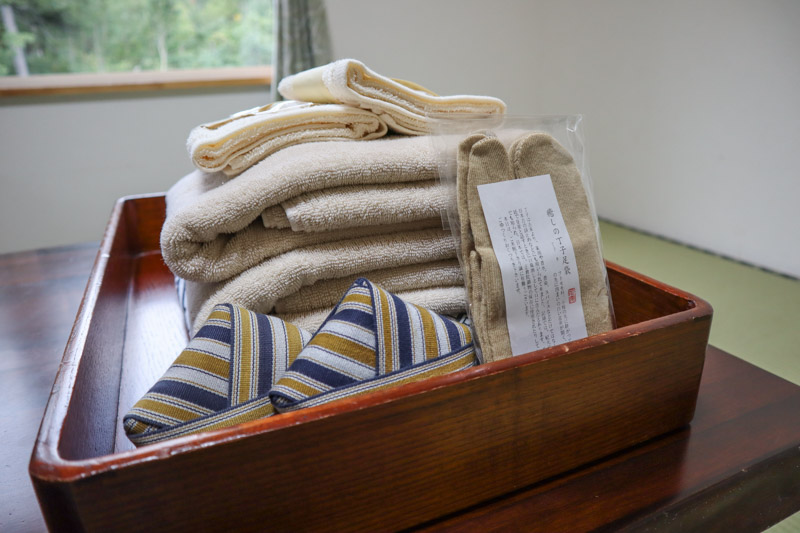
After unpacking, grab a shokudō casual snack of ramen and/or enjoy the onsen spa which has an inside and outside steamy experience. The staff will make up your bed as you dine later.
It is common for hotels to switch the genders of the onsens so you can experience both onsens, or in Daisetsu Kogen Sanso’s case, all four baths. Cool eh?
If you don’t want to fully enter a bath or are just passing by Daisetsu Kogen Sanso after a day of hiking you can use the foot spa at the front of the hotel. We saw a group of hikers do this as we were leaving on day three.
Note: It is advertised that there is no WiFi on the premises. There is a cosy lounge area in the shop with a coffee machine which you can chill and read a book at. Daisetsu Kogen Sanso is zen.
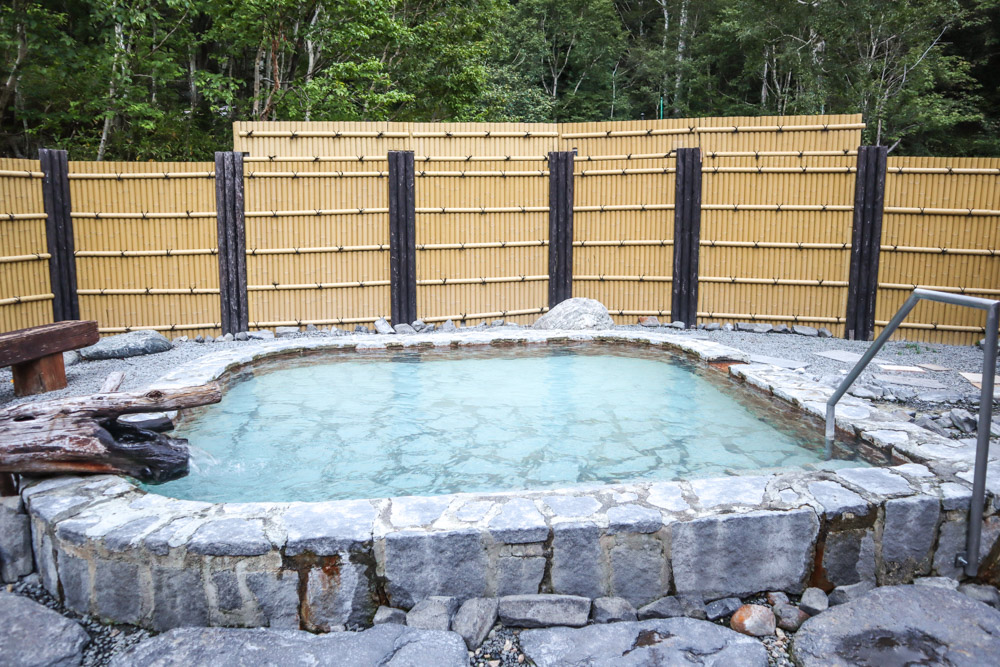
Dinner is another platter affair with plates and bowls of local produce, miso soup, rice and hot tea. Craig jokes that if this was the Scottish Highlands you’d be lucky to get a crisp sandwich this far out.
Part of the Kaiseki-style dinner often includes a hot pot where several pieces of food are cooked by a candle which your server lights for you. When the light goes out, you can remove the lid and eat.
For dessert, we enjoyed mochi which is a sweet dumpling made from mochigome rice grain. Japanese breakfast is also included in the price.
You will see a similar pattern for the evenings in Hokkaido. Dine, digest then hit the onsen! If you leave it late enough you can bathe underneath the dark sky and stars.
There is a car park for hotel guests or a shuttle bus to/from Sounkyo which can be booked at an additional cost.
During the autumn foliage, cars are prohibited so guests must use the shuttle bus service.
Call or email to book a room: 01658-5-3818 and [email protected].
If you prefer to stay in Sounkyo, give yourself 50 minutes to drive to the Bear Center tomorrow morning.
Day 3 Brown Bear Information Center ヒグマ情報センター
After breakfast, walk over to the Brown Bear (Higumam) Information Center because today you’re going bear spotting!
Between June and October, visitors are welcomed to hike the designated path around the 7km trail of forest, wetlands, onsens and ponds with the snow-capped mountains as the backdrop.
From mid-July to the start of August is prime bear sighting time but it is also when the mosquitoes are out in force so pack sprays and nets.
Somewhere among the mountains, nestled within the trees or even swimming in a pond, you might just see a bear in its natural habitat.
Bear sighting is not promised but the walk itself is a pleasant day out.
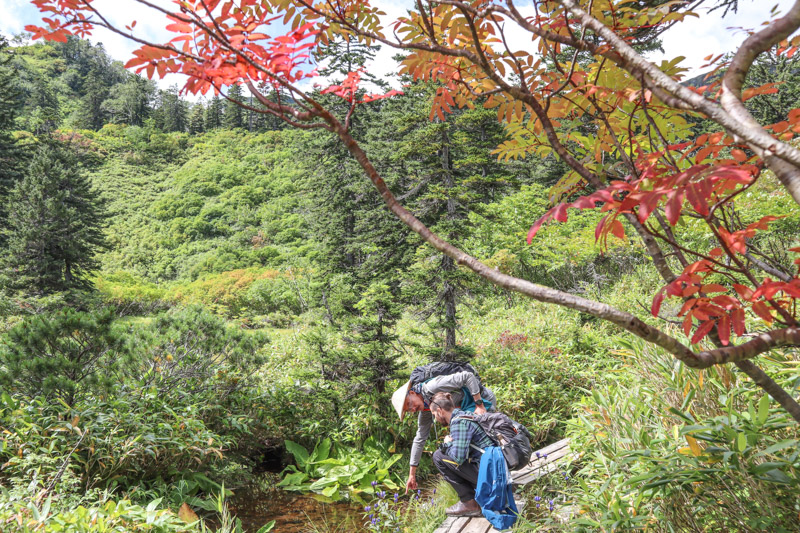
The morning begins with an information lecture (in Japanese with a written English pamphlet) about the Center and the brown bears.
For a few days in September, the Bear Center becomes a traffic light of leaves and crowds visit to see the foliage before the snow washes all the colour away.
For the remainder of the season, you will have the trail to yourself as unlike the unethical bear places in Hokkaido, this centre prides itself on not disturbing bears in their natural habitat while staff members study them.
Before you join the trail, clean your boots with the brush and water. This stops any cross-pollination of foreign seeds. Straight away you will realise how much the Center knows and cares about its surroundings.
Keep an eye out for bear scratches on trees, one of which has been embedded for over 20 years and has grown in size with the tree.
Although there were no bear sightings, we did see day old bear poo and a bear paw in the mud. You? Tell us in the comments below.
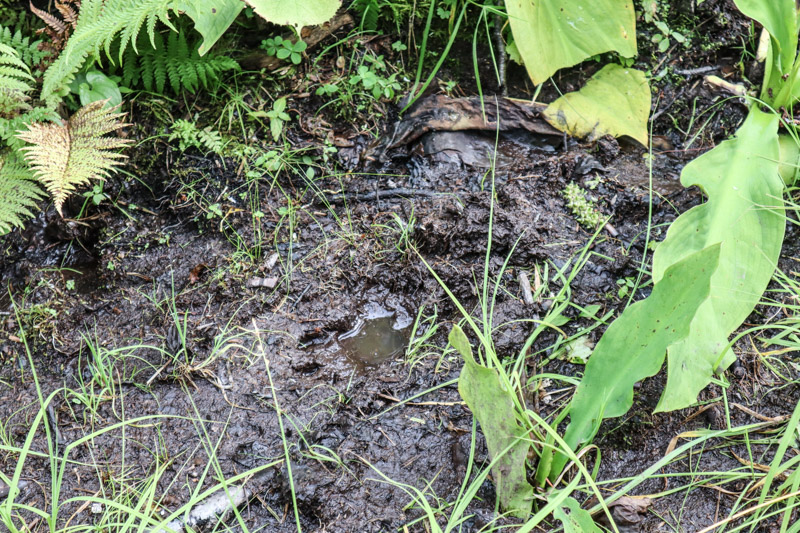
Practical Information – Bear Observation
There is nowhere to buy food on the premises and food can only be eaten at the designated ponds like Daigaku-numa Pond.
Do not eat snacks as you hike and only drink water. This rule is in place to ensure the bears’ natural habitat is not impacted by visitors.
There are no toilets on the trail and as with Mount Asahidake, you cannot use nature’s toilet.
The trail loop is 7km and takes up to five hours with food stops and photo opps.
You can walk to the Midoriuma (south of trail) and back to the Center in two hours or further to Kogenuma and back in four if you want a shorter route.
Accommodation for tonight is at Choyotei Hotel in Sounkyo which is a massive complex popular with tour groups. The hotel itself is surrounded by mountains giving Sounkyo a real alpine feel.
Buffet style dinner is served in a large room with karaoke songs belting out in the next. There is a communal onsen which we never used as we finished the relaxed dinner slightly later.
However, looking at the images, I regret that choice! Floor to ceiling windows let in floods of light, worth a visit during the day to see the mountains as you bathe.
We were told tattoos were fine but if anyone mentioned them just to be respectful in our responses.
Larger group tours open up opportunities for more people to be offended but in all honesty, we only had positive comments about ours during our three weeks in Japan.
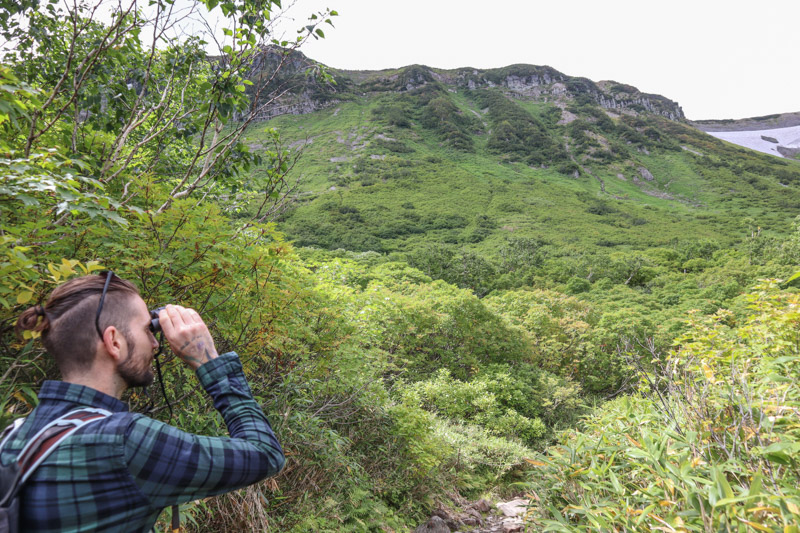
Day 4 Sounkyo Onsen
Japanese and western style buffet breakfast is served in the large hall at Choyotei Hotel. Consume some calories for a day of rafting and bike riding!
Toshii, our Japanese and English speaking guide at Alpine Rafting Tours, is one of the coolest people we’ve met.
You can tell he is self-employed by his beard, our friend whispers. A cultural aspect we hadn’t noticed!
With years of rafting experience in several countries under his life jacket, you can be certain that your rafting experience in Hokkaido is going to fun and safe.
Tours start at 9am or 1pm and require a minimum of two people. The meeting point is at the office (159 Kyōshin, Kamikawa, Kamikawa-gun, Hokkaido 078-1732) where you are asked to sign your life away and given a dry suit, shoes and a helmet in return.
There’s a toilet on site. Use it before you put the suit on.
I took my sunglasses but instantly regretted it after putting the helmet on just before the ride so leave them in the car.
After a short journey to the water, the river route will depend on the time of year and water levels, you’ll be given a briefing and time to put on your suit fully. Then it is into the water!
Toshii talks over the instructions you can expect him to shout as he navigates the team through the rapids and away from rocks and low hanging trees.
Another team member rides along in a kayak, just in case. Our ride was pretty tame and scenic. There were no water casualties but I can’t guarantee that will be the same for your experience. It is half the fun getting dumped into the water!
At the end of the ride, hot drinks and help removing your suits await. I highly recommend taking a rafting tour in Sounkyo, even if it is your first time. Set aside three hours for the tour.
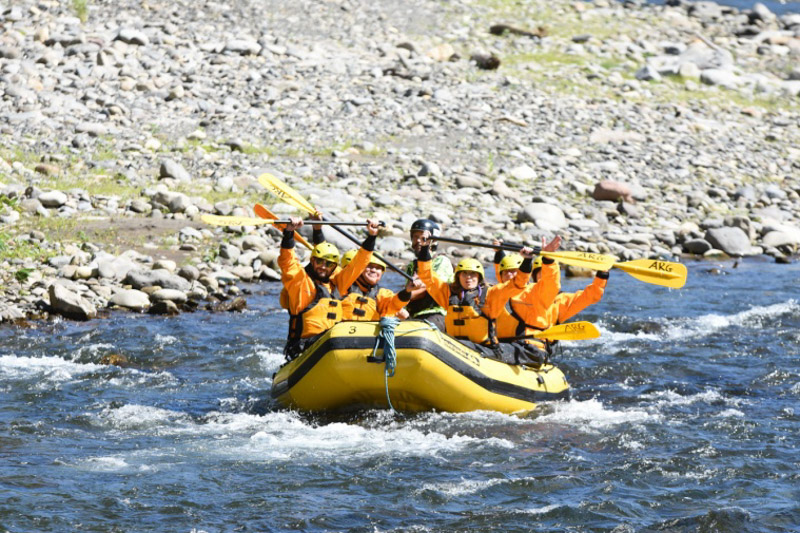
Next up is a very quick lunch and it would be rude not to try the local ramen! Ramen House Tozanken is popular with tourists and also does fried dishes if you don’t fancy a bowl of soupy goodness.
We went for a more local bowl of ramen at Asahi Shokudo Kamikawa (135 Minamimachi, Kamikawa).
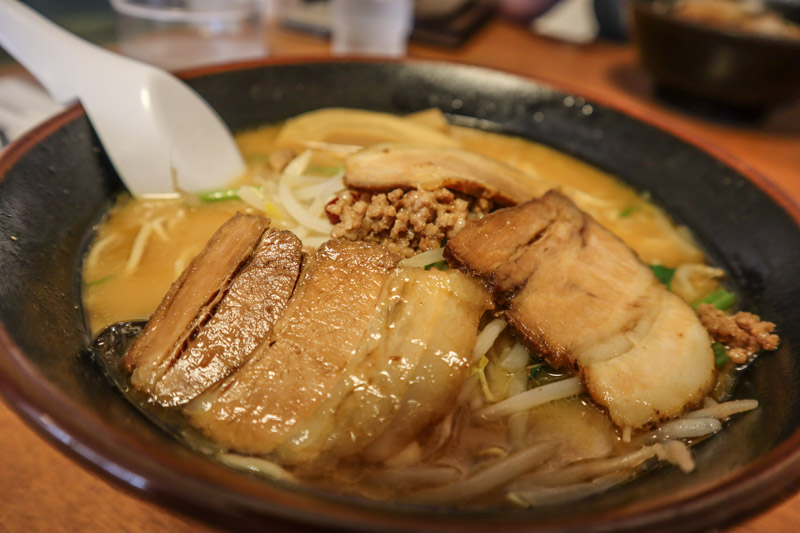
Refuelled, hit the road again, this time on a rental bike from Mount Kurodake Ropeway.
As the rental closes at 3.30pm, you can just about squeeze in an afternoon ride or save a morning of biking for day five, depending on when you need to return your car rental.
If you decide to bike this afternoon, cycle for 20 minutes to the two waterfalls in Sounkyo, Ryusei and Gin Ga.
From Gin Ga Waterfall, cycle along the Ishikari River enjoying the pockets of heat through the shadows of the trees. If you visit during June and July, the imposing mountains will be snow-capped.
The terrain changes as you turn left into the cycle pathway. Pedal through the buckwheat fields and working farms.
Return the bikes to Kurodake Ropeway by 3.30pm closing time or arrange a pick up at Kamikawa Train/Bus Station. Two-hour rental costs ¥1000 per person.
Accommodation and dinner for the night is either a second night in Sounkyo Onsen or your last night in Asahikawa city.
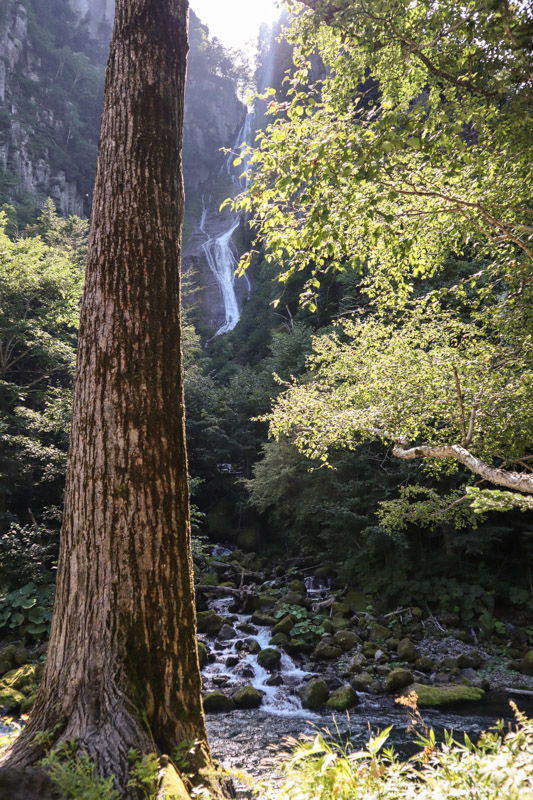
Day 5 Sounkyo or Asahikawa
Day five depends on whether you need to return your car to Asahikawa city or airport. If you do have a morning return you may want to stay in the city on night four.
If you have time, there are several things you can do around Sounkyo including taking a more leisurely cycle to see the waterfalls. You can hire bikes for a full day instead of just two hours.
Or, take a Morning Cable Car Tour with a guide which includes the Kurodake Ropeway journey. The tour takes one hour and boasts views of Sounkyo Gorge.
You can take the cable car independently to the seventh station and hike to the peak of Mount Kurodake in 1.5 hours. The Ropeway runs every 20 minutes.
If you are up for more hiking it takes a day to hike Mount Kurodake past the rim of Ohachidaira caldera and over to Mount Asahidake, the reverse route that we planned to hike on day two.
For a more relaxed hike that takes one-two hours, join the Momijidani Footpath which starts at the Sounkyo Youth Hostel which is next to Choyotei Hotel. At the end of the trail, you will see Momijidani Waterfall.
If you are into a round of golf, the scenic Sounkyo Golf Course is on the cycle route and welcomes visitors of abilities. There are toilets and a shop at the golf course if you need a comfort stop.
Sounkyo to Asahikawa: 1 hour 20 mins.
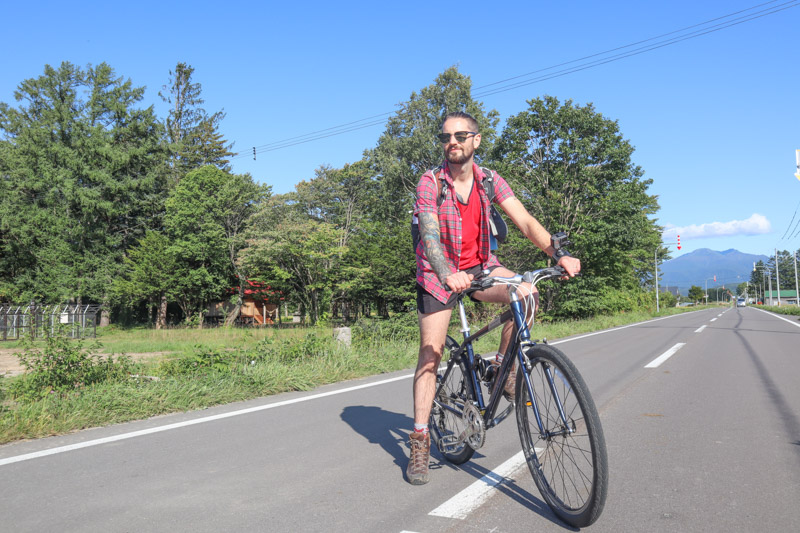
Frequently Asked Questions
When is the best time to visit Hokkaido?
This depends on what Hokkaido attractions you want to see and do.
During a Hokkaido summer itinerary, you can enjoy the warm weather and increased chances of spotting bears in July/August.
To see the foliage, aim for mid-September but be warned that the leaves turn very quickly and the area gets really busy.
For skiing and boarding season, choose to visit during November – March.
There’s even a slight chance that you could catch the end of the ski season and a cherry blossom bloom at the start of April.
Can you drive in Hokkaido in winter?
Yes, you can. Some roads may close but rental cars are equipped for winter driving and roads are cleared frequently.
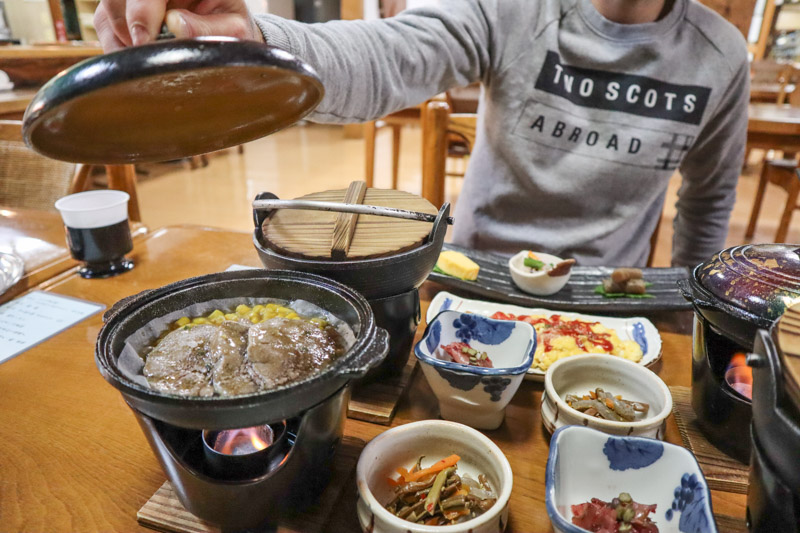
You May Also Like
- Rishiri Island in Hokkaido Guide
- Rebun Island Travel Guide
- Things to do in Asahikawa City
- What to do in Yokohama Near Tokyo
- Japan’s Hidden Gem Destinations
Planning a Japan trip?
Pin to your board for later
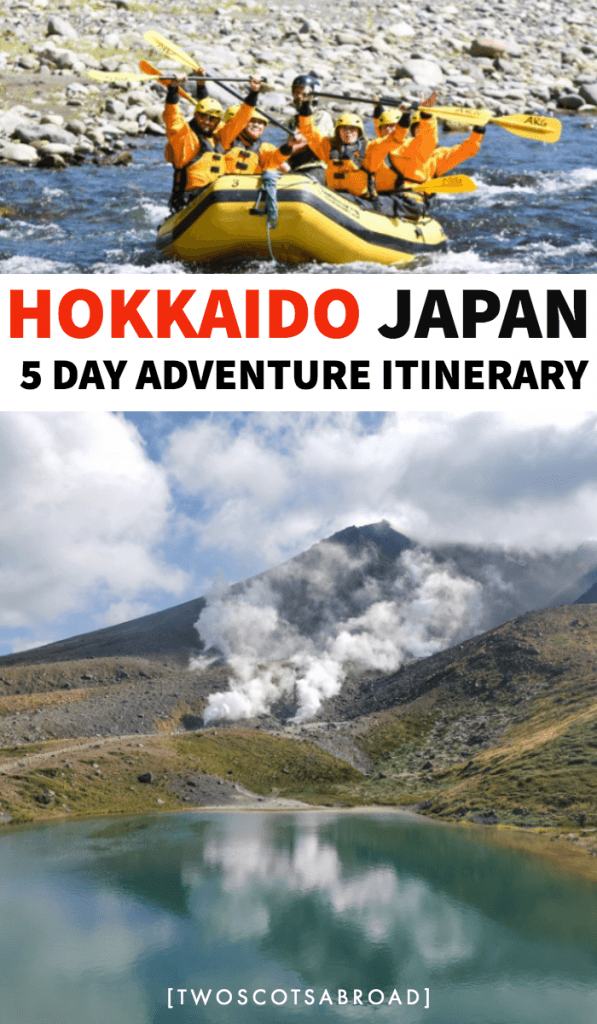
Final Words
Choosing Kamikawa in Hokkaido as the destination for your Japan road trip is a brilliant idea if you enjoy nature, wide roads, unique traditional accommodation with onsens and the prospect of seeing bears in the wild!
Support by Hokkaido District Transport Bureau. We would like to thank Kamikawa for inviting us on this adventure Hokkaido road trip! We’ve very much enjoyed getting out in the wild and meeting the locals who run businesses in the region. As always, the above opinions are our own.

